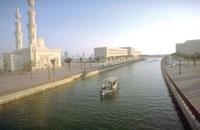
When Sharjah was awarded the status of cultural capital of the Arab world in 1998 by Unesco (United Nations Educational, Scientific and Cultural Organisation), it was an official stamp of world recognition for what many people know already knew – that Sharjah is living testament to art and heritage, contained within a thriving metropolis.
Mohamed A Al Noman, director of Sharjah Commerce and Tourism Development Authority (SCTDA, explained that the appeal of Sharjah lies in precisely this mix of the old and the new.
He explained: “The old part comes through the heritage and culture of 6,000 years of settlement; and the new is from the architecture and technology of an oil-producing nation. Sharjah is, to a certain degree, still untapped in terms of its tourism potential. The government believed it was essential to develop the infrastructure and the development of commerce and injury before pushing tourism, but we believe the time is right for people to discover Sharjah.”
For many European tourists, the emirate represents an ideal getaway, combining beach, shopping and culture – all in a family-friendly environment. Al Noman added: “Shopping is one of the most popular pastimes here in the Gulf – not least in the hot summer months. In the last couple of years, we have seen a boom in terms of shopping malls, with three new ones opening up in the last two years. However, the traditional souks, selling everything from furniture to gold and spices, are as popular as ever; indeed the Blue Souk, for example, has become a tourist attraction in its own right, thanks to its distinctive architecture as well as its traditional market feel inside.”
The family focus is a theme that runs throughout the city. Beaches are clean and safe, and the nightlife is also geared towards the family. This is one of the main attractions for visitors from overseas.
Sharjah’s 22 state-of-the-art museums play a pivotal role in attracting visitors to the emirates, with more than 500,000 people passing through their doors in 2004 alone. Perhaps the best known is the Sharjah Desert Park, which also has the Arabian Wildlife Centre, the Sharjah Natural History Museum and a Children’s Farm in its grounds.
The concept for the centre was launched by the Ruler of Sharjah, HH Sheikh Dr Sultan bin Mohammad Al Qassimi, to encourage the protection of Arabian species, and a sophisticated breeding programme has been created. This has paid off, with many indigenous species having been saved from extinction.
“The government pledges a huge amount of money back into the city,” said Al Noman. “The protection of the heritage and culture is one of the top priorities and the city is very proud of its museums. Some have been quick to point out that the speed of development of the UAE means that there can be no culture here: we say that our 22 museums, and almost 100 art galleries tell a different story. It is these cultural facilities that really set us apart. Each part of the history of the emirate is represented, but the government has given them a wide spectrum, to be used in the education of children, right through to the enjoyment of adults.”
Sharjah is steadily building a name for itself as a sports destination, with cricket and powerboating taking their place in the world calendar. Sharjah is now the leading one-day international cricket venue and has even staged Test matches. Meanwhile, the Sharjah Grand Prix, part of the Formula One Powerboat Championship, has been held in the city for the past four years, and draws consistently huge crowds.
Those interested in leisure sports can visit Khor Fakkan on the east coast of the UAE, on the Indian Ocean, which is one of the world’s leading dive sites, or explore the Hajar mountains. Al Noman concluded: “Thanks in part to the geographical spread of the emirate, from coast to coast, we play host to mountains, desert and ocean, as well as protected eco-reserves. It’s no wonder then, that we have a unique product to offer visitors. But the government has been careful to tie economic and tourism development to the infrastructure to ensure that we can service the growing number of visitors – a figure that we feel sure will increase significantly this year.”
